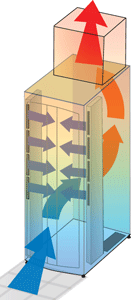
It is no longer news to anyone that the effects of Moore’s Law has created computer equipment heat loads that data centers are ill-equipped to effectively manage. Emerging conventional wisdom is beginning to settle on a response to this crisis that either involves dispersing the offending servers to reduce the heat densities or utilizing supplemental liquid cooling to remove the heat.
Chatsworth Products, Inc. (CPI) Passive Cooling™ Solutions is the best choice because it:
- reduces energy consumption
- lowers construction and operational costs
- meets Tier IV operating requirements
CPI Passive Cooling Solutions focus on controlling airflow by isolating and removing heat from the data center allowing you to maximize the cooling capacity in your space. Unfortunately passive air cooling is often excluded because of several misconceptions:
Myth 1: There is a limit to passive air cooling capacities that are well below today’s potential heat load densities.
Truth: The relationship between volume of air, heat load and temperature rise is often misapplied by considering the total temperature rise through the rack. The perceived limit to air cooling capability is based on how much air can be delivered out of a perforated access floor tile. CFD models show that chilled air is consumed by the bottom half of the cabinet, creating hot spots at the top of the cabinet. CPI Passive Cooling Solutions eliminates the dependency on chilled air from a perforated floor tile, as well as eliminates hot spots created by re-circulated air.
Myth 2: High density passive air cooling systems create unmanageable high return air temperatures.
Truth: Chilled water computer room air conditioners (CRAC) increase cooling capacity with higher return air temperatures. In instances when the return air temperature exceeds the cooling properties of economizer air, then a small amount of bypass air will suffice. Since the ideal embodiment of the passive cooling solution includes isolated return air in a ceiling plenum, bypass air may be delivered through an open ceiling grate, helping to regulate pressure in the room.
Myth 3: Lower acquisition costs for passive air solutions are overshadowed by higher operating costs than liquid cooling.
Truth: With the improved efficiency of a complete isolation between supply air and return air, close-coupled systems lose their operating cost advantage and the total cost of ownership clearly favors the well-engineered passive cooling solution.
Please refer to the complete white paper for detailed explanations behind the products and solutions of CPI Passive Cooling. For additional documentation visit our CPI Passive Cooling page.Kim Ream, eMarketing Designer